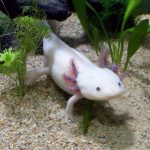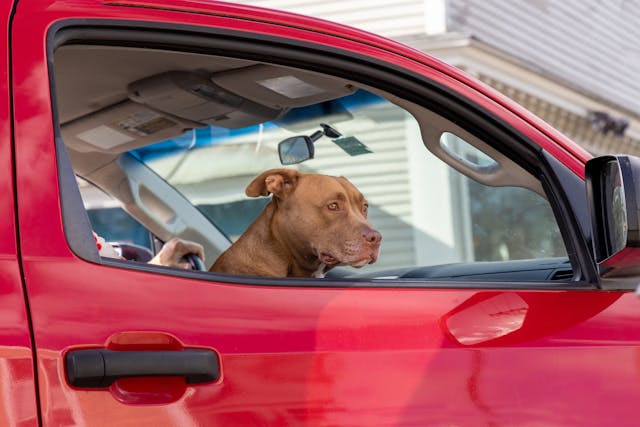
While Axolotls are known for their quirky and charming personalities, sometimes they may exhibit strange or unusual behavior that leaves us scratching our heads. Whether it’s rubbing against objects, curling their gills abnormally, or having abnormal feces, it’s important to understand the potential causes and how to address them. In this post, we’ll explore some of the most common types of abnormal behavior in Axolotls and provide some tips on how to keep your little water buddy happy and healthy.
Axolotl acting lethargic
If your axolotl is acting lethargic, check the tank conditions to make sure they are appropriate and offer a variety of food options to encourage eating. If the lethargy persists or if you notice other abnormal behaviors, seek veterinary care.
There are several reasons why your axolotl might be feeling lethargic. It could be due to the water temperature being too high or low, lack of oxygen or circulation, or overfeeding. Or maybe they’re just feeling a bit blue and under the weather – it happens to the best of us, after all! Stress from overcrowding or too much handling can also make them feel tired and drained.
Offering a variety of foods can be a great way to entice your little buddy to eat when they’re feeling lethargic. Just like us humans, axolotls can get a bit bored with the same old meals, so mixing things up with a range of tasty options can get them excited about eating again! Plus, a balanced diet with a mix of proteins, vegetables, and other nutrients can help boost their energy levels and get them back to their sprightly selves.
If the lethargy is severe, seek immediate veterinary advice. If non-severe lethargy persists or other symptoms appear, it’s always a good idea to bring your axolotl to the vet for a check-up.
Axolotl is floating uncontrollably
If your axolotl is floating uncontrollably, ensure water quality and temperature are suitable and that it’s tank is not overcrowded. Adjust feeding schedule/amount to reduce bloating. If problem persists or other abnormal behavior occurs, seek veterinary care.
Floating uncontrollably may be a sign of swim bladder disorder, which can be caused by various factors such as overfeeding, poor diet, constipation, water quality issues, or physical injuries. The swim bladder is an organ that helps fish and aquatic animals control their buoyancy and maintain their position in the water. When it is not functioning properly, the animal may have difficulty controlling its movement and may float or sink uncontrollably.
To ensure the water quality and temperature are suitable for your Axolotl, you should test the water regularly using a water testing kit to check for levels of ammonia, nitrites, nitrates, and pH. The temperature of the water should be between 16-18°C (60-64°F). Check out my other post to learn more about setting up the perfect axolotl tank.
To prevent overcrowding, make sure your tank is the appropriate size for your Axolotl, with at least 10 gallons of water per Axolotl. The water should also be well-circulated to prevent stagnant areas.
Additionally, make sure to clean the tank regularly and remove any uneaten food or waste to maintain good water quality.
To adjust an axolotl’s feeding schedule and reduce bloating, you can try feeding them smaller meals more frequently throughout the day. Alternatively, you can reduce the amount of food given during each meal and ensure that the food is properly balanced and nutritious for your axolotl’s needs. It is also important to avoid overfeeding, as excess food can cause bloating and other health problems.
Axolotl is swimming in circles
An Axolotl swimming in circles could be a sign of a neurological problem. This abnormal behavior may seem cute but it can indicate a serious health issue caused by infections, trauma or genetic issues. Seek immediate veterinary advice.
When you notice your axolotl acting strange, make sure to check the water quality and temperature to ensure they are suitable. Additionally, ensure that the tank is not overcrowded, as this can also cause stress and health problems for your axolotl.
If your axolotl’s swimming in circles persists or if you notice other abnormal behaviors, it is important to seek veterinary care. A veterinarian experienced in treating axolotls can diagnose any underlying health conditions and provide appropriate treatment. With prompt care and attention, your axolotl can overcome its neurological issues and swim around with a clear direction once again!
Axolotl is hiding for long periods of time
If your is Axolotl hiding for a long time it could mean it is overwhelmed with stress or experiencing a health issue. Check it’s tank conditions and make sure it has an abundance of other hiding spots. Monitor for other symptoms. If issue persists, seek vet care for treatment.
While it may be tempting to let your little friend have some alone time, it is important to take this symptom seriously. Hiding for long periods of time in axolotls can be caused by a variety of factors, including inappropriate tank conditions, territorial disputes with other axolotls, or underlying health issues.
To check the temperature of your axolotl’s tank, use a thermometer specifically designed for aquariums. The ideal temperature for axolotls is between 16-18°C (60-64°F).
To check water quality, use a test kit to measure pH, ammonia, nitrite, and nitrate levels. Axolotls prefer slightly alkaline water with a pH level of 7.4-7.6. Ammonia and nitrite levels should be at 0 ppm, while nitrate levels should be below 40 ppm.
To ensure the tank is not overcrowded, provide at least 10 gallons of water per axolotl and make sure they have enough space to move around comfortably.
To review your axolotl’s diet, ensure that it is receiving a varied diet of commercial pellets and live or frozen foods, such as bloodworms or brine shrimp.
If your axolotl’s hiding persists or if you notice other abnormal behaviors, it is important to seek veterinary care.

Axolotl is abnormally aggressive towards other axolotls
Axolotl aggression may indicate stress or territoriality. Ensure a spacious tank and resources. Temporarily separate the aggressive axolotl if needed. Seek vet advice if the aggression persists to prevent injuries.
If your axolotl is abnormally aggressive towards other axolotls, it may be a sign of stress, competition for resources, or a territorial issue. Firstly, ensure that the tank is spacious enough for all the axolotls, with plenty of hiding spots and resources such as food and plants. If the aggression persists, try temporarily separating the aggressive axolotl and provide it with its own tank. If the aggression continues, seek advice from a veterinarian who specializes in aquatic animals. It’s important to address aggressive behavior as soon as possible to prevent injuries to the axolotls.
Axolotl is refusing food
If your axolotl is refusing food it could be stress or a health issue. Check tank conditions, water quality, temp & lighting. Offer variety of foods & adjust feeding schedule. If axolotl still won’t eat, consult a vet. Prompt action can prevent health complications.
Axolotls may refuse food due to a variety of reasons, including stress, illness, inappropriate water conditions, and diet preferences.
Firstly, check the tank conditions to ensure that the water quality, temperature, and lighting are appropriate for your axolotl’s needs. If everything seems fine, try offering a variety of foods, such as live or frozen food, to see if there is a preference. You can also try adjusting the feeding schedule or amount. If the axolotl continues to refuse food for more than a few days, seek advice from a veterinarian. It’s important to address the issue promptly to prevent any health complications.
Axolotl is gasping for air at the surface of the water
If your Axolotl is gasping for air at the surface, it could mean poor water quality or insufficient oxygen. Check water quality and temperature, and ensure the tank is well-circulated. Consider adding an air stone or increasing water changes. Seek a veterinarian if behavior continues.
One possible cause could be inadequate aeration or filtration, which can lead to a buildup of harmful substances in the water. Other factors such as high water temperature, overcrowding, or overfeeding can also contribute to poor water quality and oxygen deprivation.
To check the water quality, use a test kit to measure levels of ammonia, nitrite, nitrate, pH, and chlorine/chloramine. Maintain levels within the acceptable range for axolotls. Use a thermometer to check the water temperature, which should be between 60-64°F (15.5-18°C). To ensure good water circulation, use a filter and/or air stone to create gentle water movement.
Axolotl is twitching
If your Axolotl is twitching, it may be due to stress, poor water quality, or an underlying health issue. Check water conditions and observe for other symptoms. If twitching persists, seek advice from a vet specializing in aquatic animals to prevent health complications.
Axolotls may twitch for various reasons, such as stress, poor water quality, injury, or illness. It could be a sign of a neurological issue, parasitic infection, or bacterial infection. It’s important to observe the Axolotl for any other abnormal behaviors or symptoms and check the tank conditions.
To observe your Axolotl’s behavior, spend some time watching it in its tank. Look for any other abnormal behaviors or symptoms, such as gasping at the surface or refusing food. Pay attention to the frequency and duration of the twitching. If it persists or is accompanied by other symptoms, seek advice from a veterinarian.
To check your Axolotl’s water conditions, you should use a water test kit that can measure pH, ammonia, nitrite, and nitrate levels. You can also use a thermometer to check the water temperature. The ideal temperature for Axolotls is between 60-68°F (16-20°C). You should also ensure that the water is well-circulated by using a filter and adjusting the water flow if necessary. Additionally, ensure that the tank is not overcrowded and that your Axolotl has adequate space to swim around. Finally, check the lighting in the tank to make sure it’s appropriate for your Axolotl’s needs.

Axolotl has abnormal shedding
If your axolotl has abnormal shedding it could indicate an underlying health issue or improper tank conditions. Check water quality, temperature, and lighting, and ensure the tank is not overcrowded. If the shedding persists or is accompanied by other symptoms, seek a veterinarian.
Abnormal shedding in axolotls can be caused by various factors, such as poor water quality, insufficient nutrition, or stress. It is important to check the water parameters and ensure they are within the appropriate range for axolotls, as well as provide a balanced diet and a stress-free environment.
To check the water quality of your Axolotl’s tank, you can use a test kit to measure the levels of ammonia, nitrite, nitrate, and pH. The temperature should be between 16-18°C (60-64°F). The lighting should be appropriate for the plants in the tank. To ensure the tank is not overcrowded, the general rule is to have at least 10 gallons of water per adult Axolotl. You can also observe their behavior to see if they have enough space to swim comfortably. If in doubt, consult with a veterinarian who specializes in aquatic animals.
Axolotl has no appetite
If your Axolotl has no appetite, check tank conditions and try offering a variety of foods, adjusting feeding schedule or amount. If appetite doesn’t return after a few days, consult a veterinarian who specializes in aquatic animals.
There could be several reasons why your Axolotl has no appetite. One possibility is that the water temperature or quality is not suitable, as this can cause stress and illness. Another possibility is that the Axolotl is sick or has an underlying health issue. Overfeeding, underfeeding, or offering food that is too large or difficult to digest can also affect appetite. Stressful environmental factors or recent changes to the tank setup can also lead to loss of appetite.
To check the tank conditions for your Axolotl, you should monitor the water quality, temperature, and lighting. Use a water testing kit to check the levels of ammonia, nitrite, nitrate, pH, and temperature. Make sure the tank is not overcrowded and the water is well-circulated.
If your Axolotl has no appetite, try offering a variety of foods such as live or frozen food to see if there is a preference. You can also try adjusting the feeding schedule or amount. If the Axolotl continues to have no appetite for more than a few days, seek advice from a veterinarian who specializes in aquatic animals.
Axolotl has abnormal discoloration of the skin
If your Axolotl has abnormal skin discoloration it may indicate a health issue or poor water quality. Check water quality, temperature, lighting, and tank conditions. Ensure water is well-circulated and tank is not overcrowded. If this or other abnormal behavior persists, seek a veterinarian.
There could be various reasons for abnormal discoloration of the skin in an Axolotl, including poor water quality, stress, injury, bacterial or fungal infection, or genetic factors.
To check the water quality of your axolotl’s tank, you can use a water testing kit to measure the levels of ammonia, nitrites, and nitrates. The ideal levels for axolotls are ammonia and nitrite levels of 0 ppm and nitrate levels below 20 ppm. You should also check the pH level, which should be between 6.5 and 8.0. If the water quality is poor, you should do a partial water change of about 25% and ensure that the filter is working properly.
To check the temperature of the water, you can use a thermometer to measure it. The ideal temperature for axolotls is between 16 and 18°C (60 and 64°F). Ensure that the temperature is consistent and not fluctuating too much.
To check the lighting, observe how much natural light is coming into the tank and how long the artificial light is on. Axolotls prefer low light conditions, so ensure that the tank is not in direct sunlight and limit the time that the artificial light is on to 10-12 hours a day.
To ensure that the tank is not overcrowded, provide at least 10 gallons of water per axolotl and ensure that they have enough space to move around. Also, ensure that the tank is well-circulated by adding a filter or an air stone to increase water movement and oxygenation.
Axolotl swims erratically or has trouble staying upright
If your Axolotl is swimming erratically, it could be a health issue or improper tank conditions. Check water quality, temperature, and lighting to ensure they meet your Axolotl’s needs, and make sure the tank is not overcrowded and has proper circulation. Seek a veterinarian if the issue persists.
There could be several reasons why your Axolotl is swimming erratically or having trouble staying upright. Some possible causes include poor water quality, inappropriate tank conditions, stress, injury or illness, or a neurological issue.
To check the water quality, you will need to use a water testing kit, which is available at most pet stores. The kit will help you measure the levels of ammonia, nitrite, nitrate, and pH in the water. These parameters should be kept within a certain range to ensure your Axolotl’s health. The recommended water temperature for Axolotls is between 16 and 18 degrees Celsius, and the lighting should be low to moderate to avoid stressing the Axolotl.
To ensure the tank is not overcrowded, you should provide at least 10 gallons of water per Axolotl. It’s also important to make sure the water is well-circulated, which can be achieved by using a filter and an air pump. You should also regularly clean the tank and change the water to prevent the buildup of waste and harmful chemicals.

Axolotl is breathing abnormally fast
Abnormally fast breathing in an Axolotl may indicate poor water quality or an underlying health issue. Check tank conditions such as temperature, lighting, and water quality. Make sure the tank isn’t overcrowded and has good circulation. If the issue persists, seek veterinary advice.
Fast breathing in Axolotls can be caused by various reasons, such as poor water quality, high temperature, inadequate oxygen, stress, or an underlying health issue.
To check Axolotl tank conditions, first use a thermometer to measure the water temperature, which should be between 60-68°F (16-20°C). Use a water test kit to check the pH, ammonia, nitrite, and nitrate levels, which should be within acceptable ranges. Ensure that the lighting is appropriate for Axolotls, which prefer low levels of light.
Make sure the tank is not overcrowded and has good water circulation, which can be achieved by using a filter and air stone. Monitor the water quality regularly and perform partial water changes as necessary to maintain proper conditions.
Axolotl has unusual gill movement
Abnormal gill movement in Axolotls can be due to poor water quality or an underlying health issue. Check tank conditions such as water quality, temperature, and lighting. Ensure the tank is not overcrowded and the water is well-circulated. If this or any other abnormal behavior persists, seek a vet.
Unusual gill movement in axolotls can be caused by a variety of factors such as poor water quality, low oxygen levels, high levels of toxins, infections, or parasites. It can also be a sign of stress or a respiratory issue. It’s important to identify the underlying cause and address it promptly to ensure the health and well-being of your axolotl.
To check the water quality of your Axolotl’s tank, use a water testing kit to measure the levels of ammonia, nitrite, nitrate, and pH. The temperature of the water should be between 16-18°C (60-64°F). Lighting should be kept to a minimum to avoid stressing the Axolotl.
To ensure the tank is not overcrowded, follow the rule of thumb of one Axolotl per 20 gallons of water. The water should also be well-circulated with the use of a filter and/or air stone.
Regular water changes of 10-20% should be done weekly to maintain good water quality.
Axolotl is swimming upside down
If your Axolotl is swimming upside down it may be a sign of a health issue, tank conditions, or over-feeding. Check the water quality, temperature, & lighting in the tank, & ensure that water is well-circulated and tank is not overcrowded. Do not over feed. If this behavior persists, seek a vet.
Some possible causes include swim bladder disorder, which can be caused by overfeeding, constipation, or poor water quality, or it could be due to an injury or infection. If the issue persists it’s important to observe your Axolotl for any other abnormal behaviors or symptoms and seek advice from a veterinarian to determine the underlying cause and proper treatment.
To check the water quality in your Axolotl’s tank, use a water testing kit to measure ammonia, nitrite, nitrate, pH, and chlorine levels. The water temperature should be between 60-64°F (15.5-18°C), and lighting should be provided for 12-14 hours a day. To ensure good water circulation, use a filter that is appropriate for the tank size, and avoid placing decorations in a way that obstructs the flow of water. To prevent overcrowding, provide at least 10 gallons of water per Axolotl, and ensure that there is enough space for them to swim around and hide.
Axolotl is producing an excessive amount of slime
Excessive slime production in Axolotls could indicate stress or poor water quality. Check pH, ammonia, nitrite, and nitrate levels and ensure good tank conditions. If slime persists, it may indicate a health issue.
If your Axolotl is producing an excessive amount of slime, it could be due to stress or poor water quality. Start by checking the water parameters such as pH, ammonia, nitrite, and nitrate levels. Ensure that the tank is not overcrowded and that the water is well-circulated. If the water quality is good and your Axolotl is still producing excessive slime, it could be a sign of a health issue.
To check the water parameters in an Axolotl tank, you can use a water testing kit or take a sample of the water to a pet store for testing. The ideal pH range for Axolotls is between 6.5 and 8.0, with a recommended range of 7.2 to 7.6. Ammonia and nitrite levels should be zero, while nitrate levels should be below 40 ppm.
To ensure that the tank is not overcrowded, a general rule is to have 10 gallons of water per adult Axolotl. A well-circulated tank can be achieved by using a filter, air pump, or other circulation equipment. It is important to maintain a consistent temperature of around 60 to 64°F (15 to 18°C) in the tank as well. Regular water changes should also be conducted to maintain good water quality.

Axolotl is rubbing against objects in its tank
If your Axolotl is rubbing against objects in its tank, it may indicate skin irritation, parasites, or poor water quality. Check water parameters and tank conditions. If water quality is good, watch for other signs of illness. If behavior persists, seek veterinary advice.
To check the water parameters in your Axolotl tank, you can use a water testing kit to measure pH, ammonia, nitrite, and nitrate levels. Ensure that the tank is not overcrowded by following the recommended tank size guidelines for Axolotls. To ensure good water circulation, use a filter rated for the size of your tank and position it properly. Additionally, make sure to perform regular water changes to maintain water quality.
Axolotl has abnormal growth rate or growths on its body
If your Axolotl has an abnormal growth rate or unusual growths on its body, it could be a sign of a health issue. Consult with a veterinarian who has experience with Axolotls to diagnose and treat the issue.
There are several possible reasons why your Axolotl may have an abnormal growth rate or growths on its body. These can include genetic factors, poor water quality, inadequate diet or nutrition, and exposure to pollutants or toxins.
Axolotl is curling its gills abnormally
Abnormal gill curling in Axolotls can signal stress or poor water quality. Check pH, ammonia, nitrite, and nitrate levels, and ensure good water circulation and no overcrowding. Observe for other signs of illness. If behavior persists, consult a vet.
To check the water parameters of your Axolotl’s tank, you can use a water test kit or take a water sample to a local pet store or laboratory for testing. Ideal pH range for Axolotls is 6.5-8.0. Ammonia and nitrite levels should be 0 ppm, while nitrate levels should be below 40 ppm.
To ensure that your Axolotl’s tank is not overcrowded and the water is well-circulated, you can provide adequate filtration by choosing a filter that is suitable for the size of your tank and performing regular maintenance on it. Avoid overfeeding your Axolotl, as excess food can contribute to poor water quality. Additionally, make sure there is enough space in the tank for your Axolotl to move around comfortably and consider adding aeration or a water pump to improve water circulation.
Axolotl has abnormal feces in its tank
Abnormal feces in an Axolotl could indicate digestive problems or parasitic infections. Observe the frequency, consistency, and color of the feces. Check your water quality and feeding regimen. If symptoms persist or other issues arise, consult a veterinarian.
To check the water quality of your Axolotl’s tank, you will need to test for pH, ammonia, nitrite, and nitrate levels. You can use test kits that are readily available at pet stores or online. Follow the instructions provided with the kit to obtain accurate readings.
To ensure that the tank is not overcrowded and that the water is well-circulated, you can use an appropriate-sized filter for your tank and perform regular water changes. Aim to change 10-20% of the water every week or as needed based on the water test results.
To adjust the feeding regimen, make sure that you are not overfeeding your Axolotl. They should be fed once a day with a variety of food, such as worms or pellets, in amounts that they can consume within 5-10 minutes. If the feces are abnormal, you may need to adjust the amount or type of food that you are providing.
This post currently has 5 responses.
-
I had no idea what kind of an animal this was so just looked it up. Very fascinating to read about and I learned something new today.
-
WOW this is the second article I have read and learned a lot from. I would like to have one but don’t know if I am up to watching for all of these possible problems
-
Pingback: Top 7 Tank Tips for Breeding Axolotls - exotails.com
-
Pingback: Understanding Axolotl Social Needs at Home - exotails.com







I had no idea this thing existed. It sounds like it is much like taking care of a dog… always be aware of their behavior.